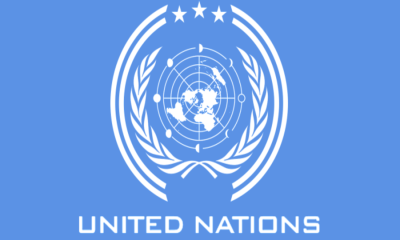WORLD
Powerful Cyclone Mocha makes landfall in Myanmar, tearing off roofs and killing at least 3
A strong storm that hit Myanmar’s shore on Sunday, knocking off roofs and killing at least three people, left thousands of people holed up in temples, pagodas, and schools.
According to Myanmar’s Meteorological Department, Cyclone Mocha made landfall Sunday afternoon in the Rakhine state of Myanmar close to Sittwe township with winds of up to 209 kilometers (130 miles) per hour. Before making landfall, the storm avoided Bangladesh’s coast by passing over Saint Martin’s Island, where it had previously caused damage and injuries.
The extent of the destruction in Sittwe was unclear when night fell. High winds earlier in the day toppled cell phone towers, cutting down connections across a large portion of the region.
Deep water surges through streets in footage gathered by local media before communications were cut off, while wind torches trees and rips roof shingles off.
In low-lying regions, residents were trapped in their homes while frightened relatives outside the township pleaded for help, according to Rakhine-based media.
According to Myanmar’s military information office, the storm in Sittwe, Kyaukpyu, and Gwa townships damaged homes, electrical transformers, cell phone towers, boats, and lampposts. It said that the storm also destroyed sports facilities on the Coco Islands, which are located 425 kilometers (264 miles) southwest of Yangon, the largest city in the nation.
According to Tin Nyein Oo, a volunteer at shelters in Sittwe, more than 4,000 of the 300,000 inhabitants of Sittwe were evacuated to neighboring towns, while more than 20,000 people were taking refuge in strong structures including monasteries, pagodas, and schools situated on the city’s highlands.
After more people than anticipated arrived, according to Lin Lin, the chairman of a local humanitarian organisation, there was not enough food in the shelters in Sittwe.
“Mocha has made landfall,” tweeted Titon Mitra, the U.N. Development Program’s representative in Myanmar. 2 million individuals are at risk. Large-scale losses and damage are anticipated. We need unrestricted access to all impacted communities in order to respond, and we are prepared.
The military administration of Myanmar is getting ready to send food, medicine, and medical professionals to the storm-devastated area, according to official media in Myanmar. After pummeling Rakhine, the storm weakened and was expected to make landfall on Monday in the central areas and the northwest state of Chin.
Several deaths brought on by wind and rain were reported in Myanmar on Sunday morning.
The bodies of a couple who were buried when a landslide brought on by heavy rain struck their home in Tachileik township were found, according to a rescue team from the country’s eastern Shan state, which made the announcement on its Facebook social media page. In the Pyin Oo Lwin township, which is located in the central Mandalay region, a man was reported to have been crushed to death when a banyan tree fell on him.
However, by early afternoon, it appeared that the storm would largely miss the country as it veered east, said Azizur Rahman, director of the Bangladesh Meteorological Department in Dhaka. Earlier, authorities in the Bangladeshi city of Cox’s Bazar, which lay in the storm’s predicted path, said they had evacuated hundreds of thousands of people.
In our Bangladesh, the risk level has significantly decreased, he told reporters.
In the afternoon, Saint Martin’s Island in the Bay of Bengal continued to experience strong gusts and rain, but feared tidal surges did not occur because the cyclone started reaching Bangladesh’s coast at low tide, according to the Jamuna TV station in Dhaka.
Leading Bengali-language newspaper Prothom Alo stated that 300 dwellings were either demolished or damaged and that about a dozen island residents were hurt. It stated one woman had suffered a critical injury.
Numerous ambulances with mobile medical teams and tons of dry food had been prepositioned by U.N. organizations and relief workers in Bangladesh in the vast refugee camps where more than 1 million Rohingya who had escaped persecution in Myanmar are now living.
A storm surge brought on by Cyclone Nargis in May 2008 wreaked havoc on the Irrawaddy River Delta’s populated areas. Tens of thousands of homes and other buildings were destroyed, and at least 138,000 people died.
Cyclones in the Bay of Bengal are intensifying more quickly, according to Roxy Mathew Koll, a climate scientist at the Indian Institute of Tropical Meteorology in Pune. She said this is partly due to climate change.
Cyclones can now sustain their intensity for several days, according to climate scientists. In 2020, Cyclone Amphan in eastern India continued to move over land as a powerful cyclone and left behind significant destruction.
Cyclones will maintain their intensity for a longer length of time “as long as oceans are warm and winds are favorable,” Koll added.
Cyclones are among the most deadly natural catastrophes in the world, especially when they strike highly populated coastal regions. Cyclones are large storms that are comparable to those known as hurricanes or typhoons in other parts of the world.
Asia Pacific
China earthquake death toll rises to 149, two still missing after a week.
The death toll from the China earthquake rises to 149, with two still missing after a week. At least 149 people were murdered in a rural location in the northern part of China by one of the most severe earthquakes that China has seen in recent years, according to official media. Two people are still missing following the magnitude-6.2 earthquake a week ago.
The earthquake’s epicenter was located in an area encompassing both the provinces of Gansu and Qinghai. The Hui people of China, a relatively small ethnic minority that stands out for having a distinctive Muslim identity, reside in significant numbers in this area.
The quake’s violent vengeance was felt most strongly in Gansu. Almost 200,000 dwellings were destroyed, and 15,000 homes were on the verge of collapsing, according to reports from Chinese official media. In the province, the severe earthquakes caused 145,000 people to be displaced, and as of December 22, 117 people had been killed and 781 others had been injured.
According to official media, as of 11 p.m. (1500 GMT) on Sunday, 32 people had perished, and two more were still missing in the region of Qinghai, which is located west of Gansu.
The local authorities have determined that the shallowness of the earthquake is responsible for the severity of the damage. The thrust-type rupture during the earthquake and the comparatively soft sedimentary rock in the area contributed to the shakes’ significantly increased destructive power.
Most of the destroyed residences were constructed at an earlier age and were constructed out of brick-wood or earth-wood buildings. Because their load-bearing walls were created from the earth, the local authorities have stated they have inadequate defenses against earthquakes.
In addition, they stated that the tragedy has brought to light the critical need to increase the earthquake resilience of dwellings in rural areas.
Those provinces that are located on the northeastern limit of the tectonically active Qinghai-Tibetan plateau, which includes the majority of Tibet, Qinghai, Gansu, and sections of Xinjiang, as well as the rocky highlands in the western part of Sichuan, are prone to experiencing earthquakes.
In the province of Sichuan, a magnitude-6.6 earthquake occurred ten years ago, resulting in the injuries of over 6,700 people and the deaths of over 160 others. Two thousand seven hundred people lost their lives as a result of the devastating earthquake that struck Yushu, which is primarily Tibetan, in 2010.
AFRICA
The UK paid Rwanda an additional $126 million for the contested migrant plan.
As the tab for Britain’s controversial proposal to relocate asylum seekers to the East African nation continues to increase, the United Kingdom paid Rwanda an extra 100 million pounds ($126 million) in April. This was in addition to the 140 million pounds it had already provided Rwanda.
Even though the Rwanda project is at the core of the policy that British Prime Minister Rishi Sunak is employing to discourage illegal immigration, there have been no individuals sent to Rwanda as of yet due to legal challenges that have taken place since the initiative was introduced in 2022.
After Sunak’s immigration minister resigned this week, the polarizing policy is now regarded as a danger to Sunak’s leadership, which is anticipated to be challenged in the election that will take place the following year.
According to a letter that the British Ministry of the Interior issued on Thursday, the United Kingdom plans to give Rwanda fifty million pounds in addition to the 240 million pounds it has already provided to the East African nation.
The opposition Labour Party criticized the disclosures regarding the rising cost of a scheme that legal experts warned could collapse. Some parliamentarians within Sunak’s party are also expected to express their disapproval of the idea.
A statement by Yvette Cooper, the shadow interior minister for the Labour Party, on social networking site X, said, “Britain cannot afford more of this costly Tory chaos and farce.”
On Friday, however, the newly appointed minister for legal migration, Tom Pursglove, explained what he called the “investment” of 240 million pounds. He stated that once the Rwanda policy was operational, it would reduce the money spent on hosting asylum-seekers in the United Kingdom.
“When you consider that we are unacceptably spending 8 million pounds a day in the asylum system at the moment, it is a key part of our strategy to bring those costs down,” Pursglove explained to Sky News.
Pursglove stated that the money donated to Rwanda would assist in the country’s economic growth and help get the asylum relationship with the United Kingdom up and running.
There was no connection between the money sent to Rwanda and the treaty that the two nations signed on Tuesday, according to the letter from the Ministry of the Interior.
The treaty aims to respond to a ruling by the Supreme Court of the United Kingdom, which stated that the deportation plan would contravene local laws based on international human rights standards.
“The Government of Rwanda did not ask for any payment in order for a Treaty to be signed, nor was any offered,” according to the correspondence.
After Robert Jenrick resigned from his position as immigration minister on Wednesday, Sunak made a plea to fellow Conservative parliamentarians on Thursday to come together in support of his Rwanda proposal. He stated that the emergency legislation the government had drafted to get the scheme up and running did not go far enough.
Africa
UK interior minister travels to Rwanda to resurrect asylum plan.
On Tuesday, the Minister of the Interior of the United Kingdom, James Cleverly, came to Rwanda to sign a new treaty. This was done to circumvent a court judgment that blocked the government’s contentious policy of transferring asylum seekers to the East African nation.
The Rwandan plan is at the core of the government’s attempt to reduce migration, and it is being closely monitored by other nations who are considered to be considering policies that are comparable to Rwanda’s.
In a decision handed down a month ago, the Supreme Court of the United Kingdom stated that such a move would violate international human rights norms embedded in domestic legislation.
Following the decision, the United Kingdom has been making efforts to revise its agreement with Rwanda to incorporate a legally binding treaty that guarantees Rwanda would not remove asylum seekers brought there by the United Kingdom. This is one of the primary concerns of the court.
Several attorneys and charitable organizations have said that it is highly improbable that deportation flights will begin before the election. With a lead of more than ten percentage points in the polls, the opposition Labour Party intends to abandon the Rwanda policy if it is victorious.
A meeting between Cleverly, who arrived in Kigali, the capital of Rwanda, on Tuesday morning, and Vincent Biruta, the country’s Minister of Foreign Affairs, is scheduled to take place to sign the agreement.
“Rwanda cares deeply about the rights of refugees, and I look forward to meeting with counterparts to sign this agreement and further discuss how we work together to tackle the global challenge of illegal migration,” Cleverly says.
The United Kingdom aims to transfer thousands of asylum seekers who came to its beaches without authorization to Rwanda under the plan that was agreed upon the previous year. This discourages migrants from crossing the Channel from Europe in tiny boats.
In exchange, Rwanda has been given an initial payment of 140 million pounds, equivalent to 180 million dollars, along with the promise of additional funds to cover the costs of housing and medical treatment for any deported persons.
THE PRESSURE
A great deal of pressure is being put on Prime Minister Rishi Sunak to reduce net migration, which reached a record high of 745 thousand people in the previous year, with the vast majority of migrants entering through legal channels.
“Stop the boats” is one of the five goals that Sunak has set for his government. The influx of asylum seekers who pay people smugglers for their crossings of the Channel, which frequently take place in boats that are overloaded and not seaworthy, is one of the aims that Sunak has set.
The Supreme Court determined that the Rwanda plan should not be implemented because there was a possibility that refugees who were deported would have their claims incorrectly evaluated or that they would be sent back to their country of origin to suffer persecution.
In the latter part of this week, it is anticipated that the new treaty will be followed by the release of legislation declaring Rwanda a so-called safe nation. This law is intended to prevent legal challenges against the planned deportation flights.
Despite this, this will probably result in a fresh set of political and legal difficulties.
An immigration attorney at Harbottle & Lewis named Sarah Gogan stated that the government’s policy will be challenged due to Rwanda’s history of violations of human rights provisions.
“Rwanda is an unsafe country and this is not a quick fix,” added the politician. “You cannot in a matter of weeks or months reform a country and turn it into one with an impartial judiciary and administrative culture.”
Another “gimmick” was what Yvette Cooper, the spokesperson for the Labour Party’s home affairs department, called the most recent measures proposed by the administration.
Whether or not to design the law in a way that would avoid subsequent legal challenges is still up for debate by the administration.
Several members of the Conservative Party in parliament are putting pressure on the government to incorporate a “notwithstanding” clause into Rwanda’s policy. This clause would disapprove the domestic and international human rights commitments of the United Kingdom regarding Rwanda.
However, some politicians within the ruling party, such as Robert Buckland, have stated that such a move would be “foolish” and undermine the Good Friday Agreement, which is primarily responsible for ending three decades of carnage in Northern Ireland. This is because the European Convention on Human Rights supports the treaty.
-

 Europe7 months ago
Europe7 months agoRussia’s Shoigu accuses the West of seeking to expand the Ukraine war to the Asia-Pacific.
-

 Geopolitics & Foreign Policy6 months ago
Geopolitics & Foreign Policy6 months agoTurkey’s Erdogan says he may visit Egypt soon, discuss Gaza patients -media.
-

 America8 months ago
America8 months agoRepublican US House to hold first Biden impeachment inquiry hearing
-

 Geopolitics & Foreign Policy6 months ago
Geopolitics & Foreign Policy6 months agoRussia deploys new nuclear missile in Kaluga region – RIA
-

 Geopolitics & Foreign Policy6 months ago
Geopolitics & Foreign Policy6 months agoCeasefire takes hold in Gaza ahead of hostage release; aid enters enclave.
-

 Gender, Sexuality & Identity8 months ago
Gender, Sexuality & Identity8 months agoGreenland women ask Denmark for compensation over involuntary birth control.
-

 Global Issues & Cooperation8 months ago
Global Issues & Cooperation8 months agoHuman rights in Russia have ‘significantly deteriorated’ – UN expert.
-

 TECH6 months ago
TECH6 months agoAustralia to amend laws to regulate digital payments like Apple and Google Pay.






